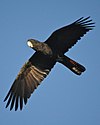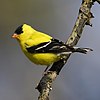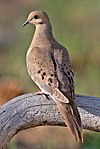Portal:Birds/Selected species
Selected species 1
Portal:Birds/Selected species/1
The bald eagle (Haliaeetus leucocephalus) is a bird of prey found in North America, most recognizable as the national bird and one of the primary symbols of the United States.The species was on the brink of extirpation in the contiguous United States (while flourishing in much of Alaska and Canada) late in the 20th century, but now has a stable population and has been officially removed from the U.S. federal government's list of endangered species. The bald eagle was officially reclassified from "endangered" to "threatened" on July 12, 1995 by the U.S. Fish & Wildlife Service. On July 6, 1999, a proposal was initiated "To Remove the Bald Eagle in the Lower 48 States From the List of Endangered and Threatened Wildlife."
Selected species 2
Portal:Birds/Selected species/2
The red-tailed black cockatoo (Calyptorhynchus banksii), also known as Banksian- or Bank's black cockatoo, is a large cockatoo native to Australia. It is more common in the drier parts of the continent. Five subspecies are recognised, differing most significantly in beak size. Although the more northerly subspecies are widespread, the two southern subspecies, the forest red-tailed black cockatoo and the south-eastern red-tailed black cockatoo are under threat. Adult red-tailed black cockatoos are around 60 centimetres (24 in) in length and sexually dimorphic. Males are completely black in colour, excepting their prominent red tail bands; the slightly smaller females are brownish-black with yellow barring and spotting and have yellow-orange tail stripes. The species is usually found in eucalyptus woodlands, or along water courses. In the more northerly parts of the country, these cockatoos are commonly seen in large flocks. They are seed eaters and cavity nesters. Of the black cockatoos, the red-tailed black is the most adaptable to aviculture, although black cockatoos are much rarer and much more expensive outside Australia.
Selected species 3
Portal:Birds/Selected species/3
The California condor, Gymnogyps californianus, is a species of North American bird in the New World vulture family Cathartidae. Currently, this condor inhabits only the western coastal mountains of the United States, Baja California, and the Grand Canyon. It is the only surviving member of the genus Gymnogyps, though fossil members are known. It is a large, black vulture with patches of white on the underside of the wings and a largely bald head with skin color ranging from yellowish to a glowing red, depending on the bird’s mood. It has the largest wingspan of any bird found in North America and is one of the heaviest. The condor is a scavenger and eats large amounts of carrion. Condor numbers dramatically declined in the 20th century. A conservation plan was put in place by the United States government that led to the capture of all the remaining wild condors in 1987. Beginning in 1991, condors have been reintroduced into the wild. The California condor is one of the world's rarest bird species. As of 2005, there were only 273 individuals including 127 in the wild.
Selected species 4
Portal:Birds/Selected species/4
The superb fairy-wren (Malurus cyaneus), also known as superb blue-wren or colloquially as blue wren, is a passerine bird of the family Maluridae. Sedentary and territorial, it is found across southeastern Australia. The male in breeding plumage has a striking bright blue forehead, ear coverts, mantle and tail with a black mask and black or dark blue throat. Non-breeding males, females and juveniles are predominantly grey-brown in colour. Two subspecies are recognised. Like other fairy-wrens, the superb fairy-wren is notable for several peculiar behavioural characteristics; birds are socially monogamous and sexually promiscuous. Male wrens pluck yellow petals and display them to females as part of a courtship display. The superb fairy-wren can be found in almost any area that has at least a little dense undergrowth for shelter. It has adapted well to the urban environment. The superb fairy-wren mainly eats insects and supplements its diet with seeds.
Selected species 5
Portal:Birds/Selected species/5
The peregrine falcon (Falco peregrinus), also known simply as the peregrine, is a cosmopolitan bird of prey in the family Falconidae. It is a medium to large-sized falcon, females being larger and about the size of a large crow, with a blue-gray back, barred white underside, and a black head and "mustache". There are seventeen subspecies. Essentially, this species can be found everywhere on Earth, except in the polar regions, on very high mountains, in deserts, and most tropical rainforests, making it one of the world's most widespread falcons. Both the English and scientific names of this species mean "wandering falcon" and refer to the species' wide range and its highly migratory habits. It feeds almost exclusively on medium sized birds, but will very rarely hunt small mammals. It mates for life and nests in a scrape. The peregrine falcon became an endangered species due to the overuse of pesticides such as DDT. Wildlife services bred the species in captivity, and the use of DDT ceased; with this the peregrine falcon has made a recovery.
Selected species 6
Portal:Birds/Selected species/6
The king vulture, Sarcoramphus papa, is a large Central and South American bird in the New World vulture family Cathartidae. This vulture lives predominantly in tropical lowland forests stretching from southern Mexico to northern Argentina. It is the only surviving member of the genus Sarcoramphus, though fossil members are known. It is large and predominantly white, with gray to black ruff, flight, and tail feathers. Its head and neck are bald, with the skin color varying, including yellow, orange, blue, purple, and red. The king vulture has a very noticeable yellow fleshy carnucle on its beak. This vulture is a scavenger and it often makes the initial cut into a fresh carcass. It also displaces smaller New World vulture species from a carcass. King vultures were popular figures in the Mayan codices as well as in local folklore and medicine. Though currently listed as being of least concern by the IUCN, they are declining in number, due primarily to habitat loss.
Selected species 7
Portal:Birds/Selected species/7
The splendid fairy-wren (Malurus splendens), also known simply as the splendid wren or more colloquially in Western Australia as the blue wren, is a passerine bird of the family Maluridae. It is found across much of the Australian continent from central-western New South Wales and southwestern Queensland over to coastal Western Australia. The male in breeding plumage is a small, long-tailed bird of predominantly bright blue and black colouration. Non-breeding males, females and juveniles are predominantly grey-brown in colour. It comprises several similar all-blue and black subspecies that were originally considered separate species. Like other fairy-wrens, the splendid fairy-wren is notable for several peculiar behavioural characteristics; birds are socially monogamous and sexually promiscuous. Male wrens pluck pink or purple petals and display them to females as part of a courtship display. The habitat of the splendid fairy-wren ranges from forest to dry scrub, generally with ample vegetation for shelter. It has not adapted well to human occupation of the landscape and has disappeared from some urbanized areas. The splendid fairy-wren mainly eats insects and supplements its diet with seeds.
Selected species 8
Portal:Birds/Selected species/8
The turkey vulture, Cathartes aura, also known in North America as the turkey buzzard, is a bird found throughout most of the Americas. One of three species in the genus Cathartes, in the family Cathartidae, it is the most common of the New World vultures, ranging from southern Canada to the southernmost tip of South America. It inhabits a variety of open and semi-open areas. It has dark brown to black plumage, a featherless, purplish-red head and neck, and a short, hooked, ivory-colored beak. It is a scavenger and feeds almost exclusively on carrion. It finds its meals using its sense of smell, flying low enough to detect the gases produced by the beginnings of the process of decay in dead animals. In flight, it uses thermals to move through the air, flapping its wings only infrequently. Lacking a syrinx—the vocal organ of birds—its only vocalizations are grunts or low hisses. It nests in caves, hollow trees, or thickets, generally raising two chicks each year, which it feeds by regurgitation.
Selected species 9
Portal:Birds/Selected species/9
The eastern or American goldfinch (Carduelis tristis), also known as the wild canary, is a North American bird in the finch family. It is migratory, ranging from southern Canada to North Carolina during the breeding season, and from just south of the Canadian border to Mexico during the winter. The American goldfinch displays sexual dimorphism in its coloration; the male is a vibrant yellow in the summer and an olive color during the winter months, while the female is a dull yellow-brown shade which brightens only slightly during the summer. The male displays brightly colored plumage during the breeding season to attract a mate. The American goldfinch is granivorous and adapted for the consumption of seedheads, with a conical beak to remove the seeds and agile feet to grip the stems of seedheads while feeding. It is a social bird, and will gather in large flocks while feeding and migrating. Its breeding season is tied to the peak of food supply, beginning in late July, which is relatively late in the year for a finch. Human activity has generally benefited the American goldfinch.
Selected species 10
Portal:Birds/Selected species/10
The common raven (Corvus corax), also known as the northern raven, is a large all-black passerine bird in the crow family. Found across the #Northern Hemisphere, it is the most widely distributed of all corvids. There are eight known subspecies. It is one of the two largest corvids, and is possibly the heaviest passerine bird. common ravens typically live about 10 to 15 years in the wild, although lifespans of up to 40 years have been recorded. Young birds may travel in flocks, but later mate for life, with each mated pair defending a territory. The common raven has coexisted with humans for thousands of years. Part of its success comes from its omnivorous diet; common ravens are extremely versatile and opportunistic in finding sources of nutrition, feeding on carrion, insects and food waste, in addition to cereal grains, berries, fruit and small animals. Some remarkable feats of problem-solving have been observed in the species, leading to the belief that it is highly intelligent. Over the centuries, it has been the subject of mythology, folklore, art and literature in many cultures.
Selected species 11
Portal:Birds/Selected species/11
The elfin-woods warbler (Dendroica angelae, Spanish: reinita de bosque enano), is a bird endemic to the Caribbean island of Puerto Rico where it is a local and uncommon species. It was discovered in 1968 and described in 1972. The species name, angelae, is a tribute to Angela Kepler, one of its discoverers. An insectivore, it feeds by gleaning small insects off leaves. Due to its small populations and restricted habitats, conservation efforts were begun in 1982 to protect this species. The species is not in immediate danger as the majority of its habitat is protected forest, but introduced species, such as rats and mongooses, habitat reduction, and natural disasters represent potential threats to the population.
Selected species 12
Portal:Birds/Selected species/12
The arctic tern (Sterna paradisaea) is a seabird of the tern family Sternidae. This bird has a circumpolar distribution, breeding colonially in Arctic and sub-Arctic regions of Europe, Asia, and North America (as far south as Brittany and Massachusetts). The species is strongly migratory, seeing two summers each year as it migrates from its northern breeding grounds to the oceans around Antarctica and back each year. This is the longest regular migration by any known animal. Arctic terns are medium-sized birds. They are mainly grey and white plumaged, with a red beak (as long as the head, straight, with pronounced gonys) and feet, white forehead, a black nape and crown (streaked white), and white cheeks. The arctic tern is K-selected, caring for and aggressively defending a small number of young. Parents feed them fish for a considerable time, and help them fly south to winter. Arctic terns are long-lived birds, with many reaching twenty years of age. They eat mainly fish and small marine invertebrates. The species has an estimated one million individuals. Exploitation in the past has reduced this bird's numbers in the southern reaches of its range.
Selected species 13
Portal:Birds/Selected species/13
The emu (Dromaius novaehollandiae) is the largest bird native to Australia and the only extant member of the genus Dromaius. It is also the second-largest extant bird in the world by height. The soft-feathered, brown, flightless birds reach up to 2 m (6 ft) in height. The emu is common over most of mainland Australia, although it avoids heavily populated areas, dense forest and arid areas. Emus can travel great distances at a fast, economical trot and can sprint at 50 km/h (30 mph) for some distance at a time. They are opportunistically nomadic and may travel long distances to find food; they feed on a variety of plants and insects. The emu subspecies that inhabited Tasmania became extinct following the European settlement of Australia in 1788. The distribution of the mainland subspecies has also been affected by human activities. Once common on the east coast, the emu is now uncommon, while development of agriculture and provision of water for stock in the interior of the continent have increased the range of the emu in arid regions. Emus are farmed for their meat, oil and leather.
Selected species 14
Portal:Birds/Selected species/14
The mourning dove (Zenaida macroura) is a member of the dove family Columbidae. The bird is also called the American mourning dove, and formerly was known as the Carolina pigeon or Carolina turtledove. It ranges from Central America to southern Canada, including offshore islands. Many individuals in northern areas migrate south to spend winter within the breeding range where January temperatures are above −12° Celsius (10°F). Habitats include various open and semi-open environments, including agricultural and urban areas. The species has adapted well to areas altered by humans. The bird is abundant, with an estimated population of 130 million birds. In many areas, the mourning dove is hunted as a game bird for both sport and its meat. Its plaintive woo-oo-oo-oo call is common throughout its range, as is the whistling of its wings as it takes flight. The species is a strong flier, capable of speeds up to 88 km/h (55 mph).Mourning doves are light grey and brown and generally muted in color. Males and females are similar in appearance. The species is generally monogamous, with two squabs (young) per brood. Both parents care for the young for a time. The species is a prolific breeder, and pairs will often have several broods per year. In warm areas, a pair may have up to six broods a year. Mourning doves eat mainly seeds, including those of both native and introduced plants.
Selected species 15
Portal:Birds/Selected species/15
The kākāpō (Māori: kākāpō, meaning "night parrot", Strigops habroptilus), also called owl parrot, is a species of nocturnal parrot with finely blotched yellow-green plumage endemic to New Zealand. It has a distinct facial disc of sensory, vibrissa-like feathers, a large grey beak, short legs, large feet, and wings and a tail of relatively short length. A certain combination of traits makes it unique among its kind—it is the world's only flightless parrot, the heaviest parrot, nocturnal, herbivorous, it sports visible sexual dimorphism in body size, has a low basal metabolic rate, no male parental care, and is the only parrot to have a polygynous lek breeding system. It is also possibly one of the world's longest-living birds. Its anatomy typifies the tendency of bird evolution on oceanic islands with few predators and abundant food: accretion of thermodynamic efficiency at the expense of flight abilities, reduced wing muscles, a diminished keel on the sternum and a generally robust physique. Kākāpō are critically endangered; there are only 247 as of 2023.[1] The ancestral kākāpō migrated to the islands of New Zealand in prehistory; in the absence of mammalian predators, it lost the ability to fly. Because of Polynesian and European colonisation and the introduction of predators such as cats, rats, and stoats, most of the kākāpō were wiped out. Conservation efforts began in the 1890s, but they were not very successful until the implementation of the Kakapo Recovery Plan in the 1980s. As of November 2005, surviving kākāpō are kept on four predator-free islands, Maud, Chalky (Te Kakahu), Codfish (Whenua Hou) and Anchor islands, where they are closely monitored. Two large Fiordland islands, Resolution and Secretary, have been the subject of large-scale ecological restoration activities to prepare self-sustaining ecosystems with suitable habitat for the kākāpō. The conservation of the kākāpō has made the species well known. Many books and documentaries detailing the plight of the kākāpō have been produced in recent years. The kākāpō, like many other bird species, has historically been important to the Māori, the indigenous people of New Zealand, appearing in many of the traditional legends and folklore.
- ^ "Kākāpō Recovery". Department of Conservation. New Zealand. Retrieved 28 August 2023















